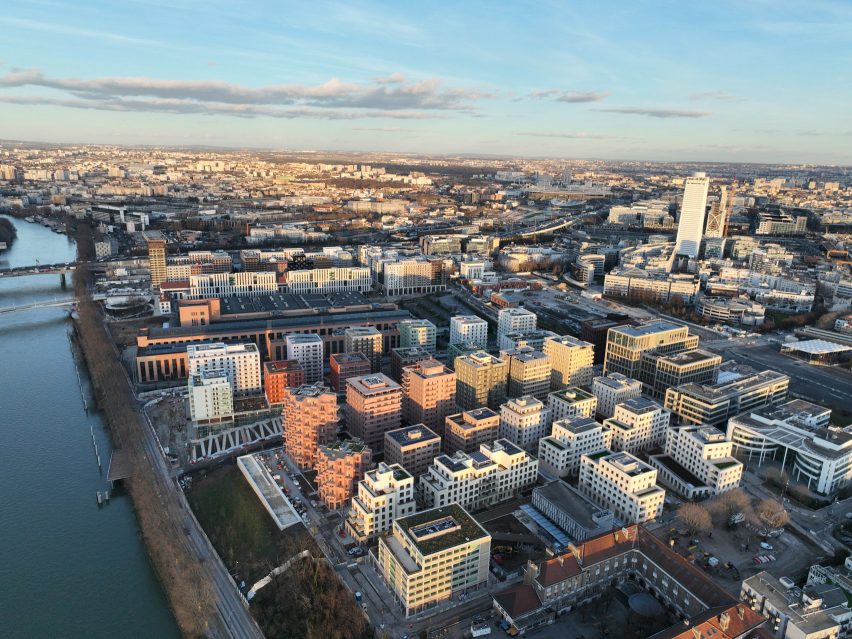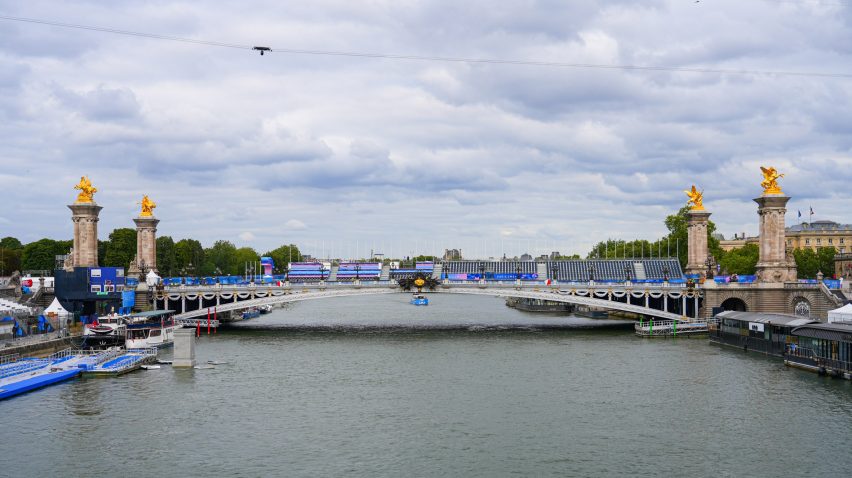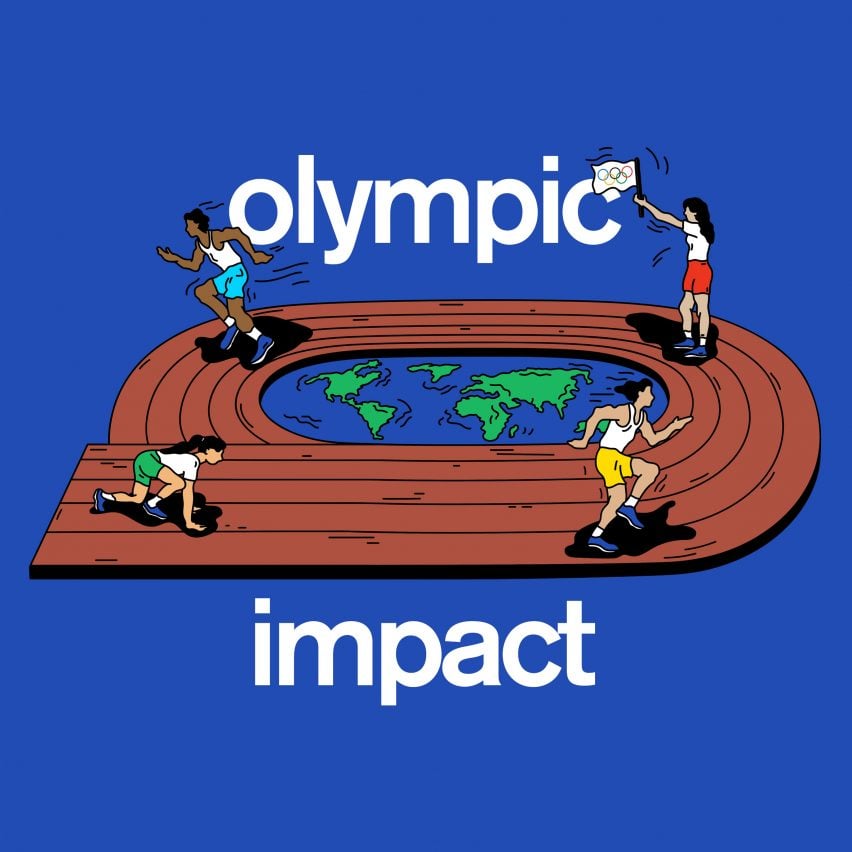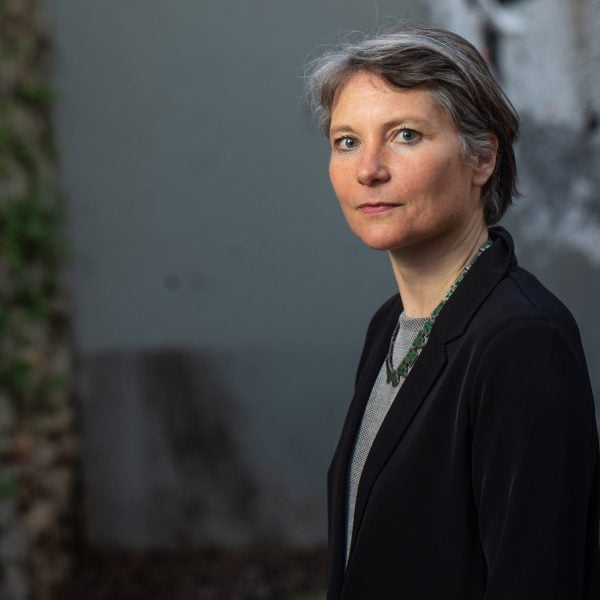The Olympic Games should be reformed to enable more democratic input from the communities they affect the most, argues Parisian journalist Jade Lindgaard in this Olympic Impact interview.
“With the games, there’s never enough time,” said Lindgaard, author of Paris 2024: A City in the Face of Olympic Violence.
“Every four years, a giant event is organised in a different city, with conditions largely set by an external institution – the International Olympic Committee,” explained the journalist and ecology editor at the French investigative news website Mediapart.
“In order for the host country to meet this unmoveable deadline, a lot of the usual checks and controls are waived,” she told Dezeen.
“The result is top-down decision making and an erosion of the democratic process.”
In her book, Lindgaard sets out to document some of the negative effects of the Paris 2024 Olympics, from the destruction of parkland and allotments to the 1,500 people, many of them poor and vulnerable, displaced from their homes in the interest of games-related development projects.
Projects “imposed on residents from on high”
She is the first to admit that huge progress has been made in comparison to previous Olympiads – the 70,000 people displaced for the 2016 Rio games, for example, or the 60,000 ancient trees chopped down for the 2018 PyeongChang Winter Olympics.
But she argues that no-one should have to suffer negative effects from the Olympic Games, and that the model could be adapted to prevent it from happening at all.
Her investigation calls into question the oft-touted claim that the 2024 Olympics required no mega-building projects, detailing how the Paris games are inextricably entwined with one of the biggest redevelopment programmes the city has ever known.
Named Le Grand Paris, which roughly translates as Greater Paris, the operation in question dates back to the early 2010s, when president Nicolas Sarkozy tabled legislation for the building of a huge orbital metro network that would transform the suburbs around the historic core.
The idea was to link business and research clusters to each other and to Paris’s two main airports, in a context of increasing competition between global cities,” explained Lindgaard.
“Sixty-eight new stations are planned, each of which will generate redevelopment in its immediate vicinity.”

Europe’s biggest civil-engineering effort, currently estimated at €36 billion, this colossal transport-infrastructure project was barely off the starting blocks when the Olympic bid was made.
Yet the plans for the games relied heavily on it, since the extension of Line 14, which was inaugurated in June this year, now links Orly Airport in the south to the Olympic Village in the north, served by the new Saint-Denis – Pleyel metro station.
“In this sense, the games played the role of a powerful motor, vastly accelerating work since the line had to be completed by 2024,” said Lindgaard.
The same can be said of the €2 billion Olympic Village – a huge redevelopment that was only possible thanks to the new metro, whose builders like to boast that they achieved in six years what would normally take 20.
For a long-term project like Le Grand Paris, which is hugely vulnerable to the evolving priorities of changing governments, the Olympic boost has been invaluable.
That boost has had both positive and negative consequences, depending on one’s perspective.
On the one hand, the drive to decarbonise construction at the Olympic Village has accelerated the French building industry’s move towards more sustainable architecture.
On the other, the village’s host suburb – the département of Seine-Saint-Denis, one of the most underprivileged and underfunded in France – finds itself with a vast influx of new real estate that almost none of its current inhabitants can afford.
For Lindgaard, this is a missed opportunity.
“There’s a huge shortfall between what the Olympic bid seemed to promise – that the games would be an opportunity to redress the investment deficit in Seine-Saint-Denis – and what the inhabitants actually got,” she said.
“At no point were they consulted on how the Olympics might help them. Instead, turnkey projects were imposed on them from on high. Residents aren’t anti-games, but they say, ‘they’re not for us.'”
In a region where voter abstention is already significant, Lindgaard finds this deficit of democratic involvement “very worrying for the future of citizens’ political engagement”.
River cleaning “hijacked by trivial media stories”
The ambiguities of the Olympic boost also apply to the Seine, into which the authorities have poured €1.4 billion in an effort to reduce pollution.
Yet another issue that predates the bid, cleaning up the river became tied to the games after the organising committee suggested holding the triathlon and free-water swimming contests in its waters.
All those involved agree that the Olympic deadline has greatly accelerated the work as well as raising its public profile.
But Lindgaard sees two big problems. “Yes, the Seine is less polluted than it was, but it’s still not clean! Moreover, the imperative of the Olympic deadline has led the authorities to be rather economical with the truth about current pollution levels.”
She feels that, as with many aspects of the games, communication around the whole process has been murky at best.
“It’s a missed opportunity to get inhabitants involved in a real debate about the river’s future,” she lamented. “Why is it so polluted? How might we as citizens change our habits to improve the situation?”

“More broadly, it’s the whole question of the water supply: how can we use and respect it better?” she asked, citing the example of Berlin, where, she says, debates about cleaning up the River Spree are far more bottom-up and inclusive.
There’s also the question of what happens after the games. Without their impetus, will efforts to carry on depolluting the Seine flag in the future?
“I feel the whole issue has been hijacked by trivial media stories about whether mayor Hidalgo would keep her promise to swim in the river,” continued Lindgaard.
“There’s been no space for a truly democratic appropriation of this fundamental urban and ecological challenge.”
Nor, she fears, will any of these lessons have been learned in time for France’s next Olympiad, which looks set to take place in just six years.
Before the 2024 contests had even begun, the country was already gearing up to host the 2030 Winter Games across two regions, Auvergne-Rhône-Alpes and Provence-Alpes-Côte-d’Azur.
In a context of Alpine climate change where snow is scarcer every year, “they’re planning a real industrialisation of the mountains. There’ll be new roads, improved ski resorts, even a new ice rink in Nice,” said Lindgaard.
“I feel we’ve reached a crossroads: either we reduce tourism and try to find a way to preserve the mountain ecosystem so that it can support its inhabitants, or we continue as France has always done – by building large state-supported infrastructure projects that generate short-term economic growth.”
As with the Seine, she would like to see a true democratisation of the decision-making process, though that seems improbable given the bulldozer effect of the Olympics.
The games are an unstoppable branding exercise – there’s a huge event that must be organised in a very short time, people come from all over the world, the tourism and sports industries get a giant boost, as do a whole host of collateral developments,” concluded Lindgaard.
Despite all the well-documented issues with the Olympic model and the current paucity of host candidates, some politicians will continue to court the games with a view to just such goals.
This interview was conducted in French and has been translated into English by the author.
The portrait of Lindgaard is by Mathieu Genon.

Olympic Impact
This article is part of Dezeen’s Olympic Impact series examining the sustainability measures taken by the Paris 2024 Olympic and Paralympic Games and exploring whether major sporting events compatible with the climate challenge are possible.

